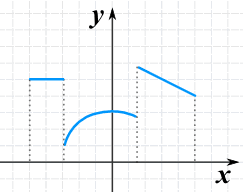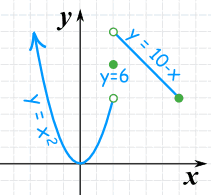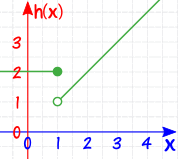Piecewise Functions
A Function Can be in Pieces
We can create functions that behave differently based on the input (x) value.

A function made up of 3 pieces
Example:
- when x is less than 2, it gives x2,
- when x is exactly 2 it gives 6
- when x is more than 2 and less than or equal to 6 it gives the line 10-x
It looks like this:

(a solid dot means "including",
an open dot means "not including")
And this is how we write it:

The Domain (all the values that can go into the function) is all Real Numbers up to and including 6, which we can write like this:
Dom(f) = (-∞, 6] (using Interval Notation)
Dom(f) = {x 
 | x ≤ 6} (using Set Builder Notation)
| x ≤ 6} (using Set Builder Notation)
And here are some example values:
Example: Here is another piecewise function:
 | | which looks like: | |  |
| What is h(-1)? | x is ≤ 1, so we use h(x) = 2, so h(-1) = 2 |
| What is h(1)? | x is ≤ 1, so we use h(x) = 2, so h(1) = 2 |
| What is h(4)? | x is > 1, so we use h(x) = x, so h(4) = 4 |
Piecewise functions let us make functions that do anything we want!
Example: A Doctor's fee is based on the length of time.
- Up to 6 minutes costs $50
- Over 6 to 15 minutes costs $80
- Over 15 minutes costs $80 plus $5 per minute above 15 minutes
Which we can write like this:

If you were there for 12 minutes what would the fee be? $80
If you were there for 20 minutes what would the fee be? $80+$5(20-15) = $105